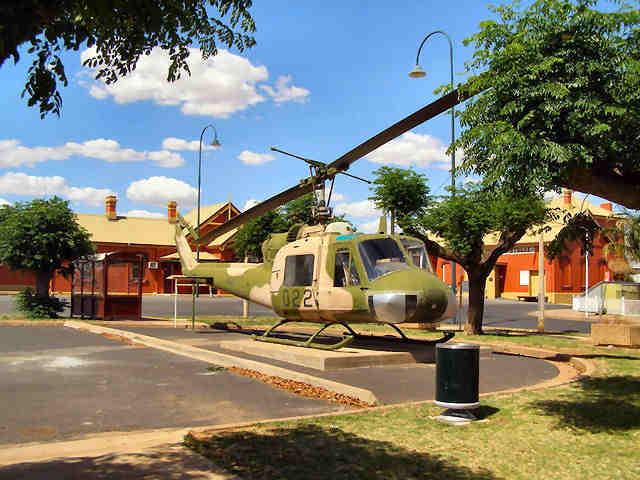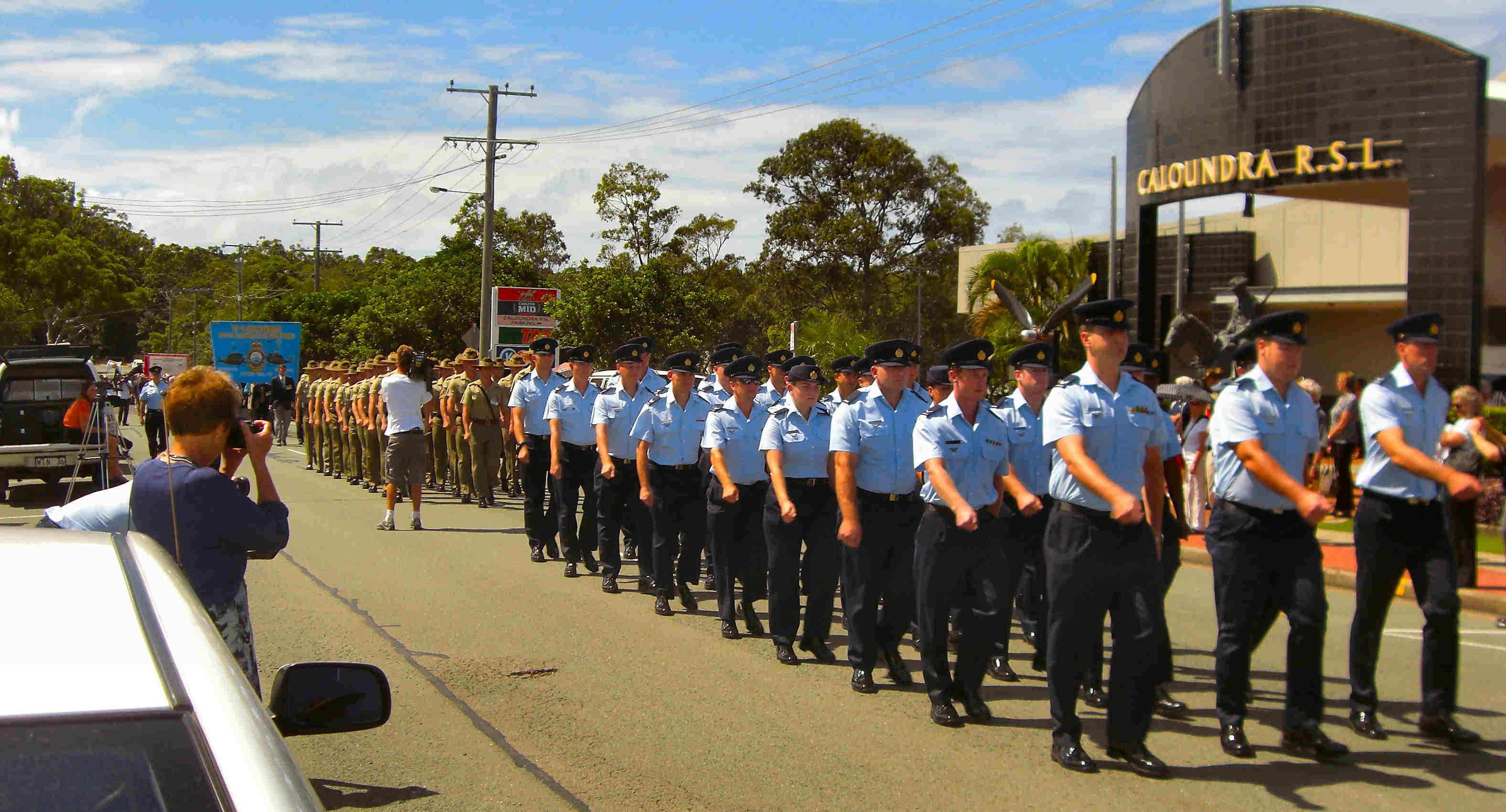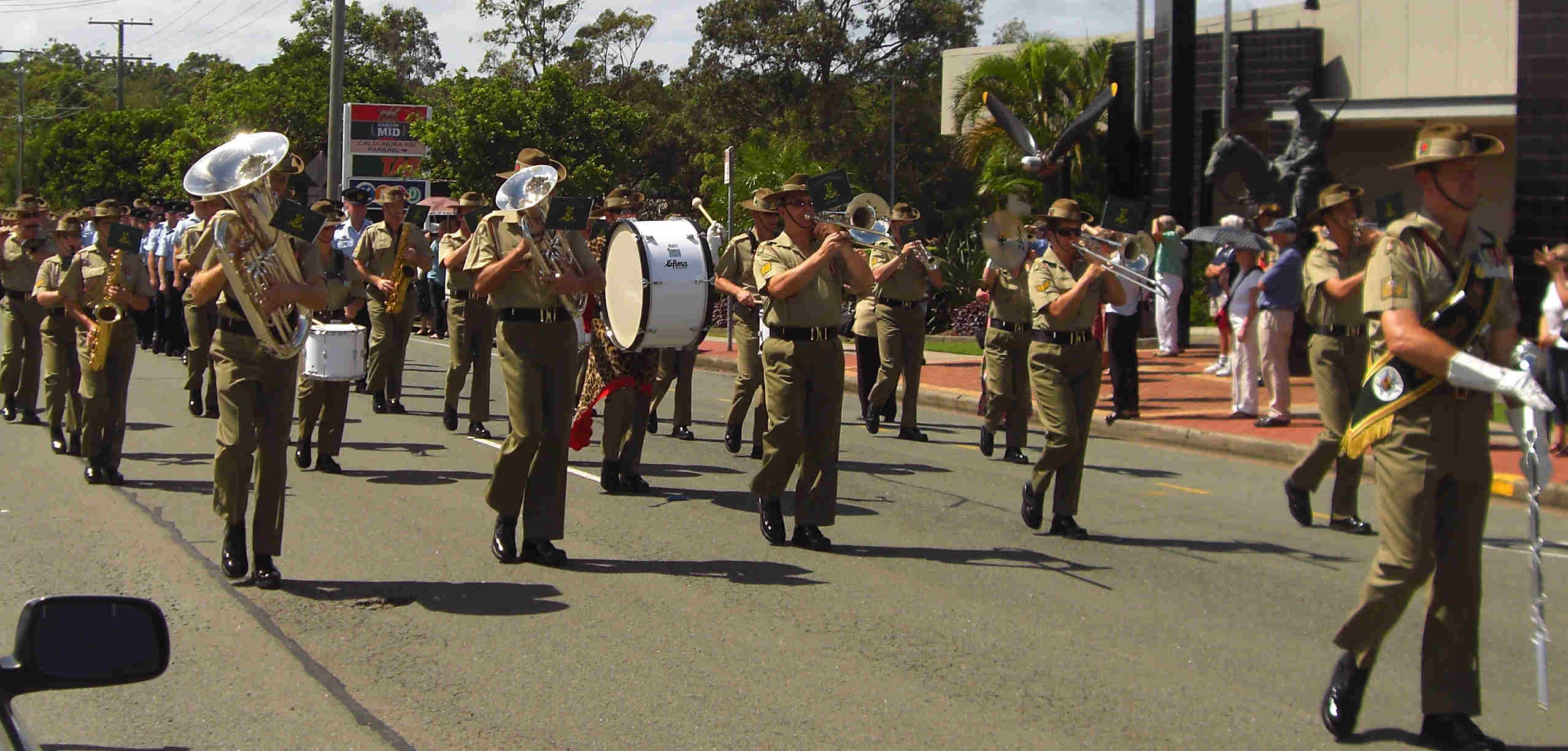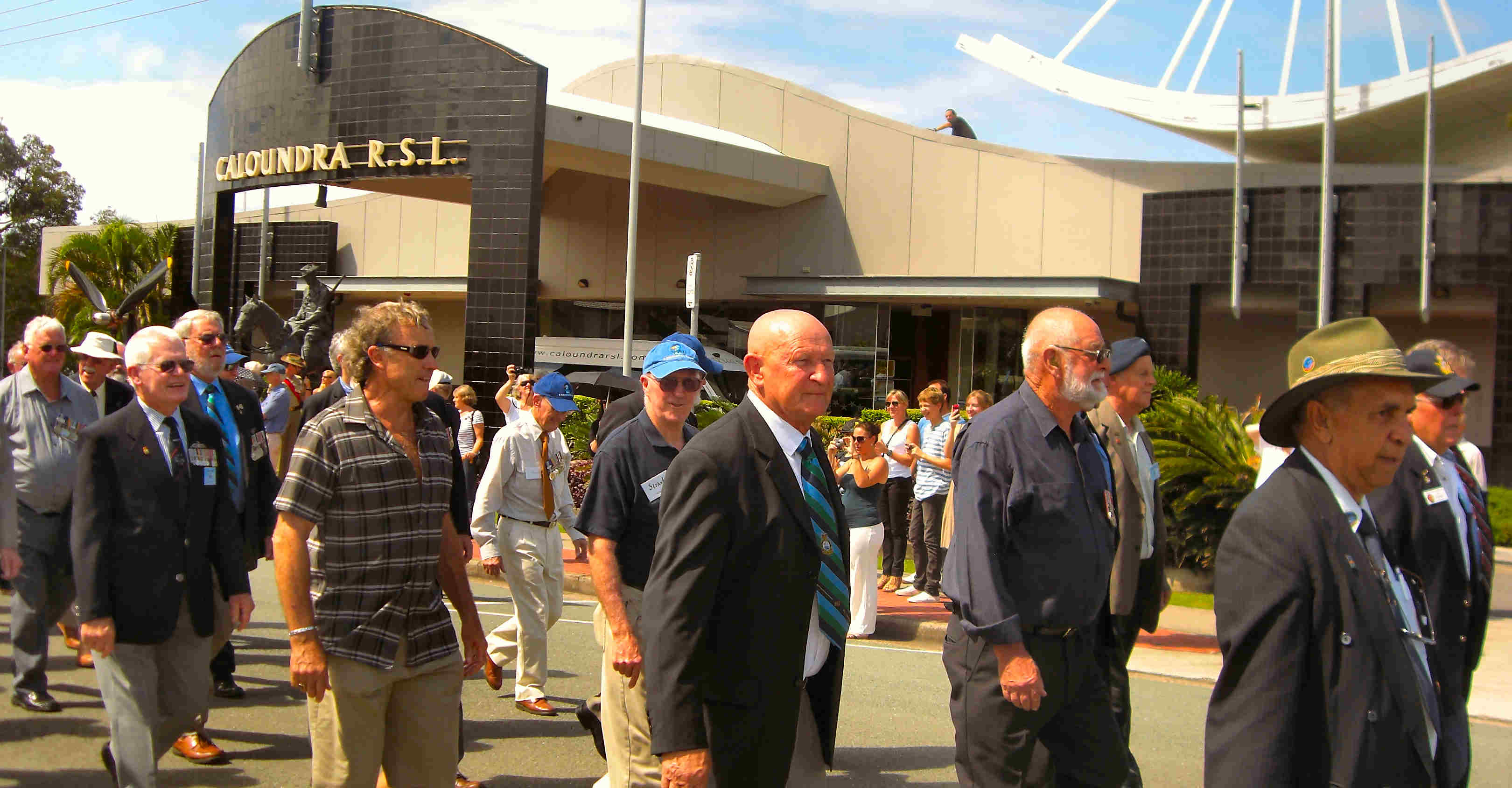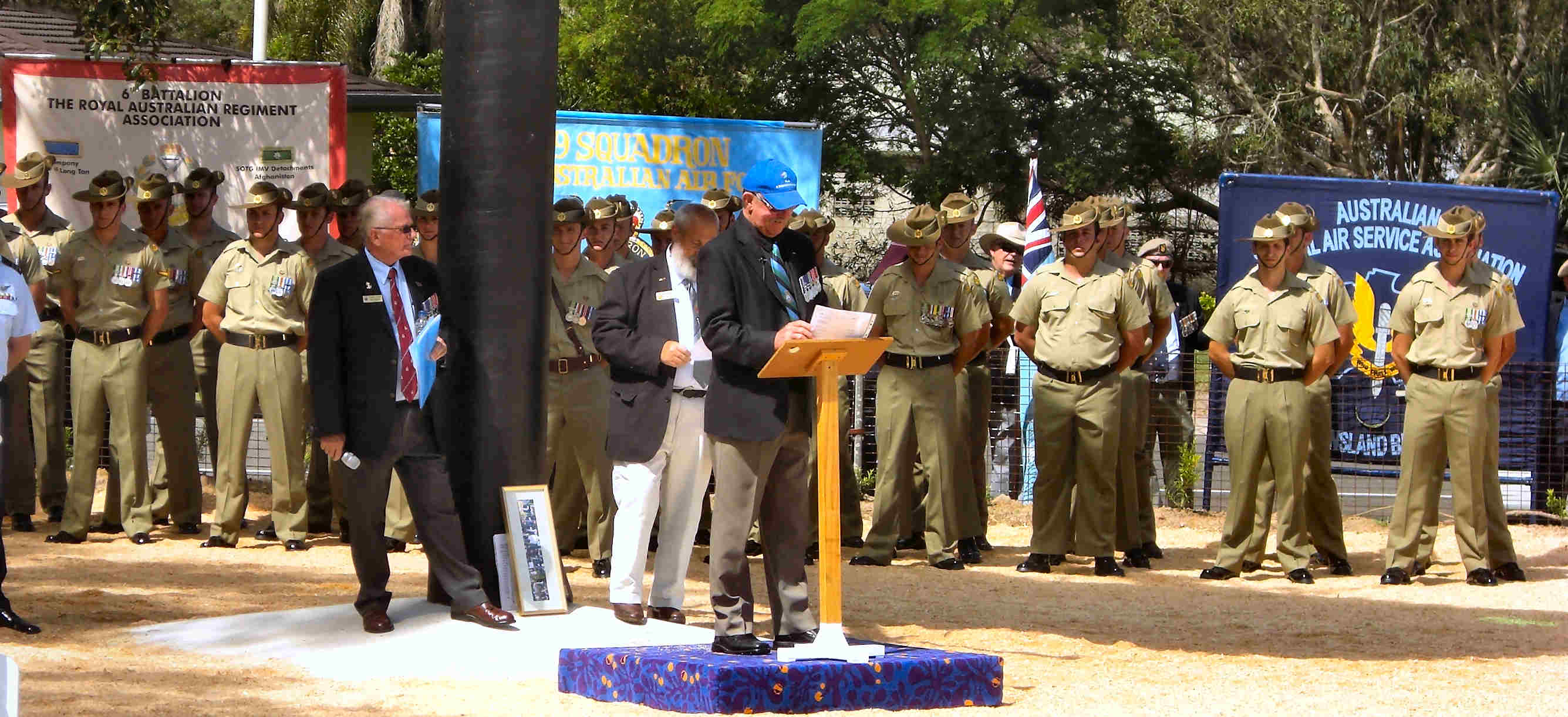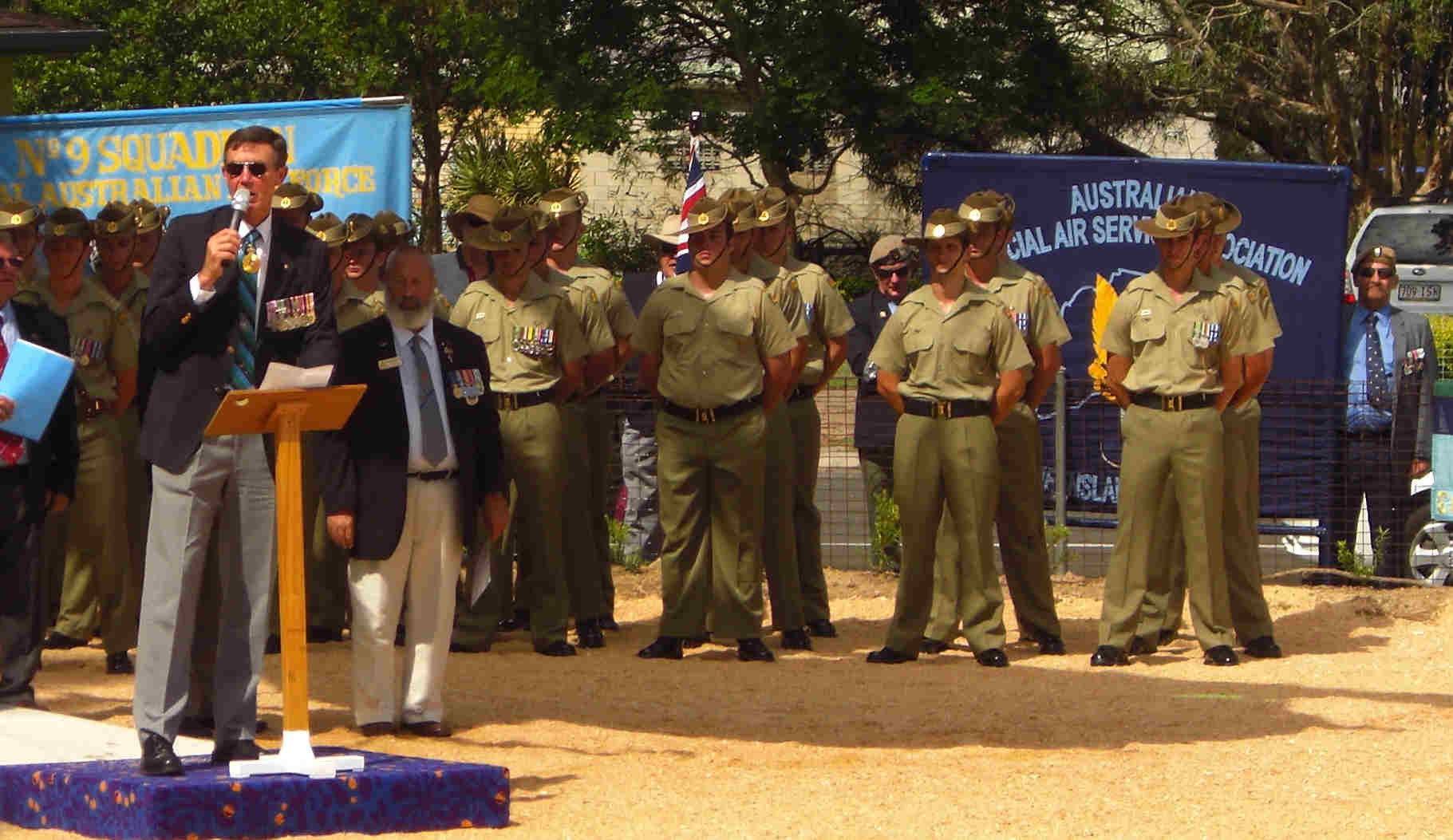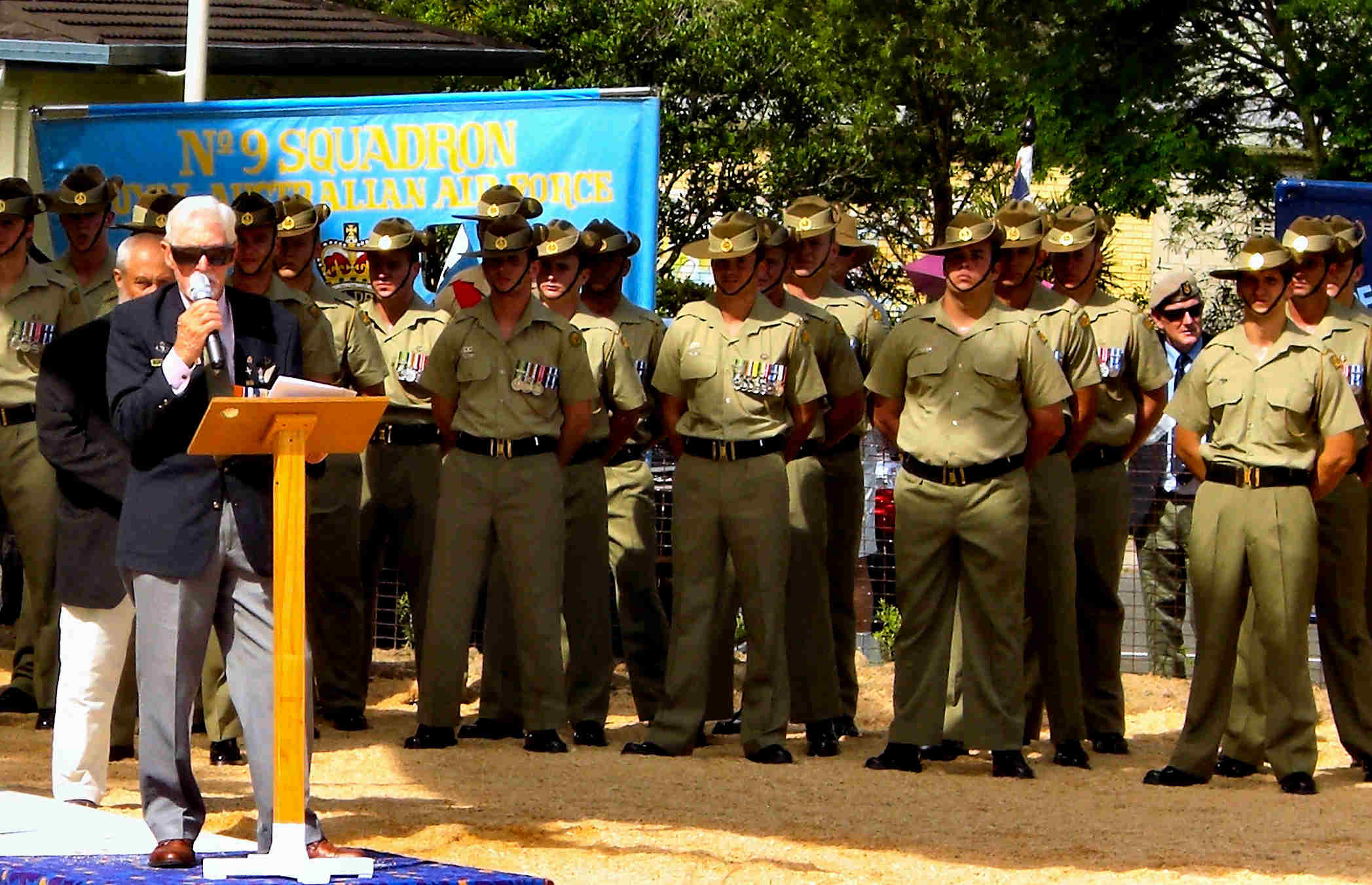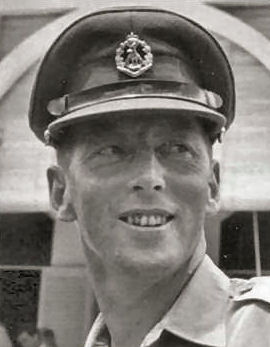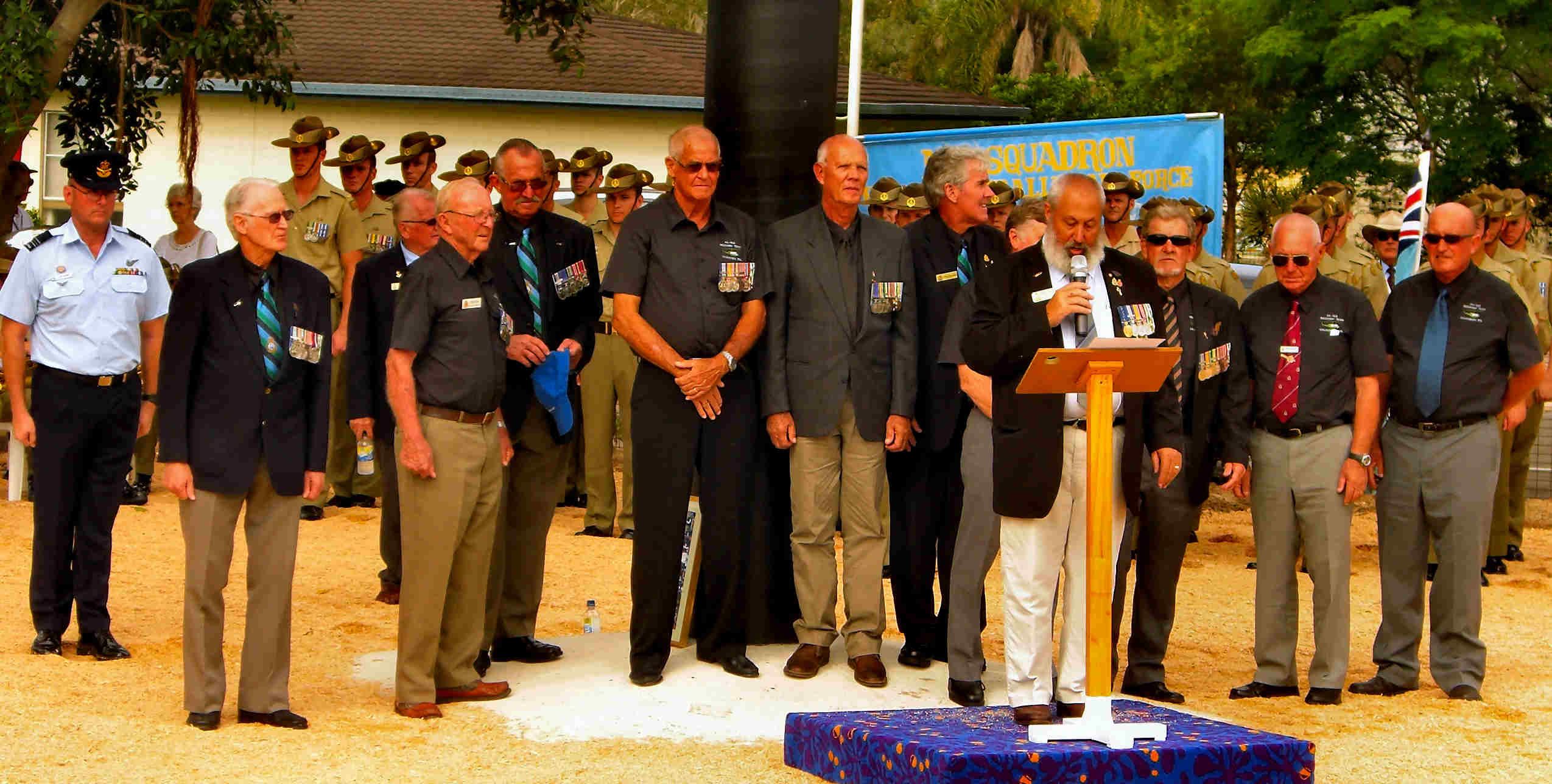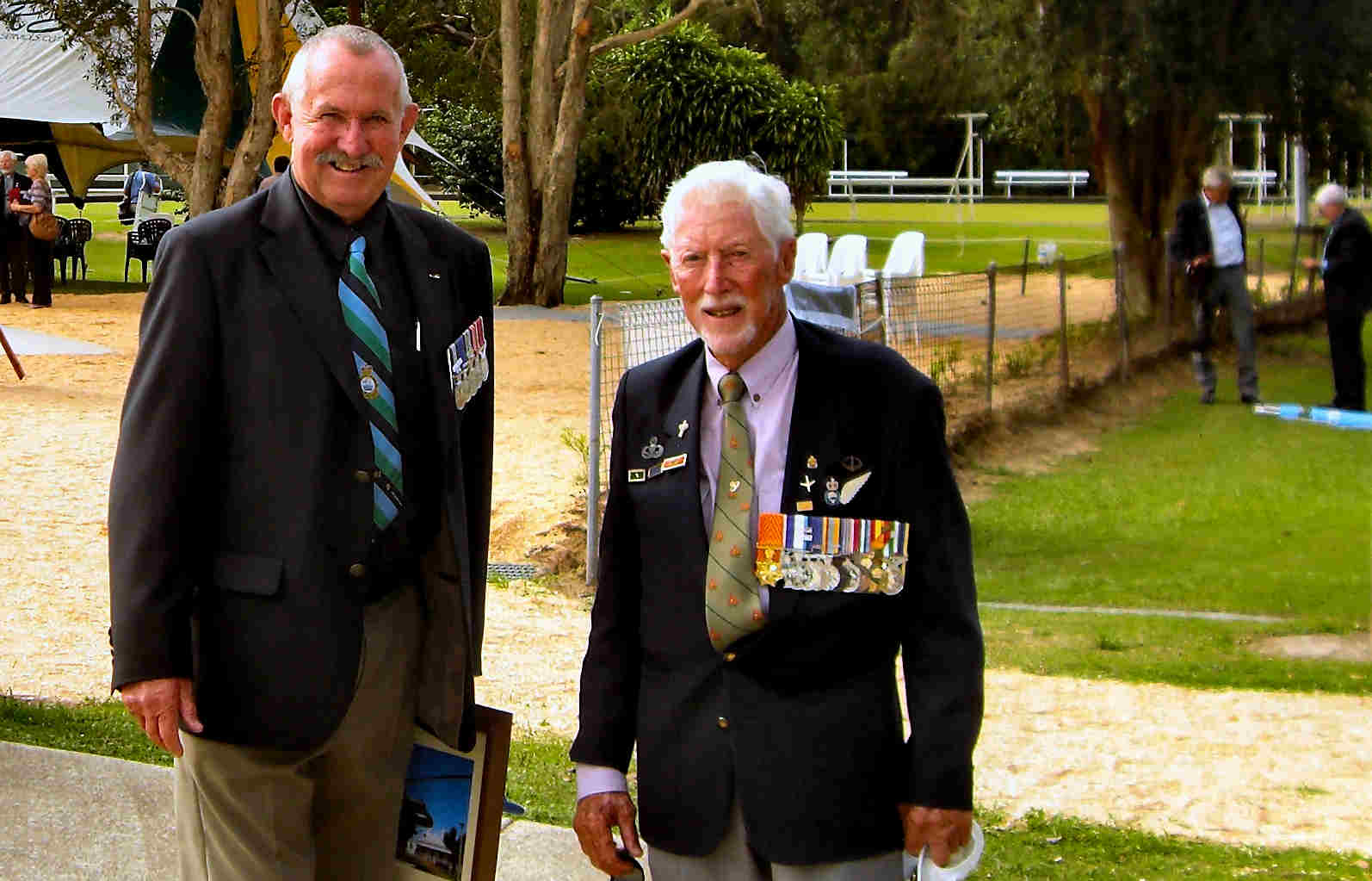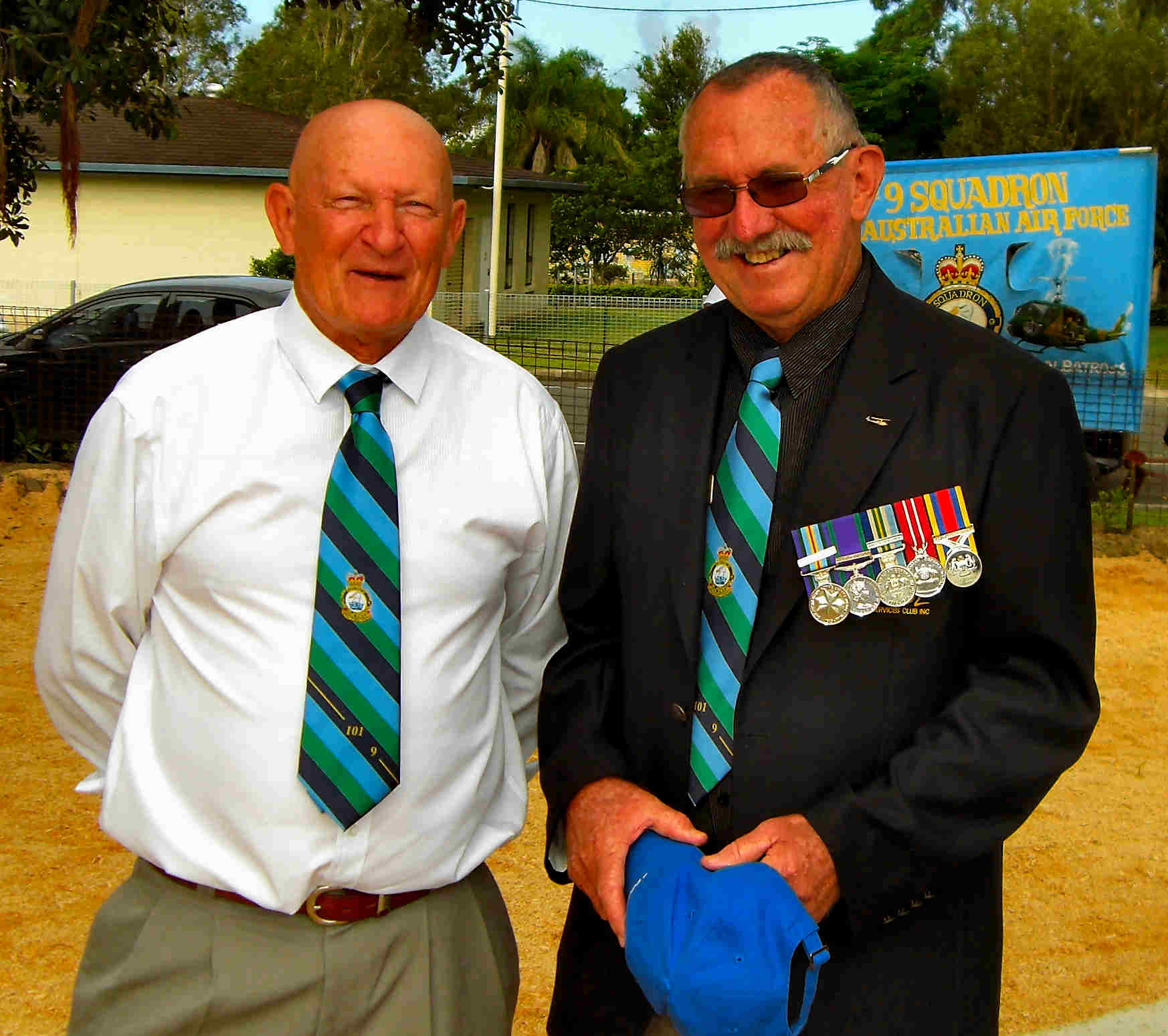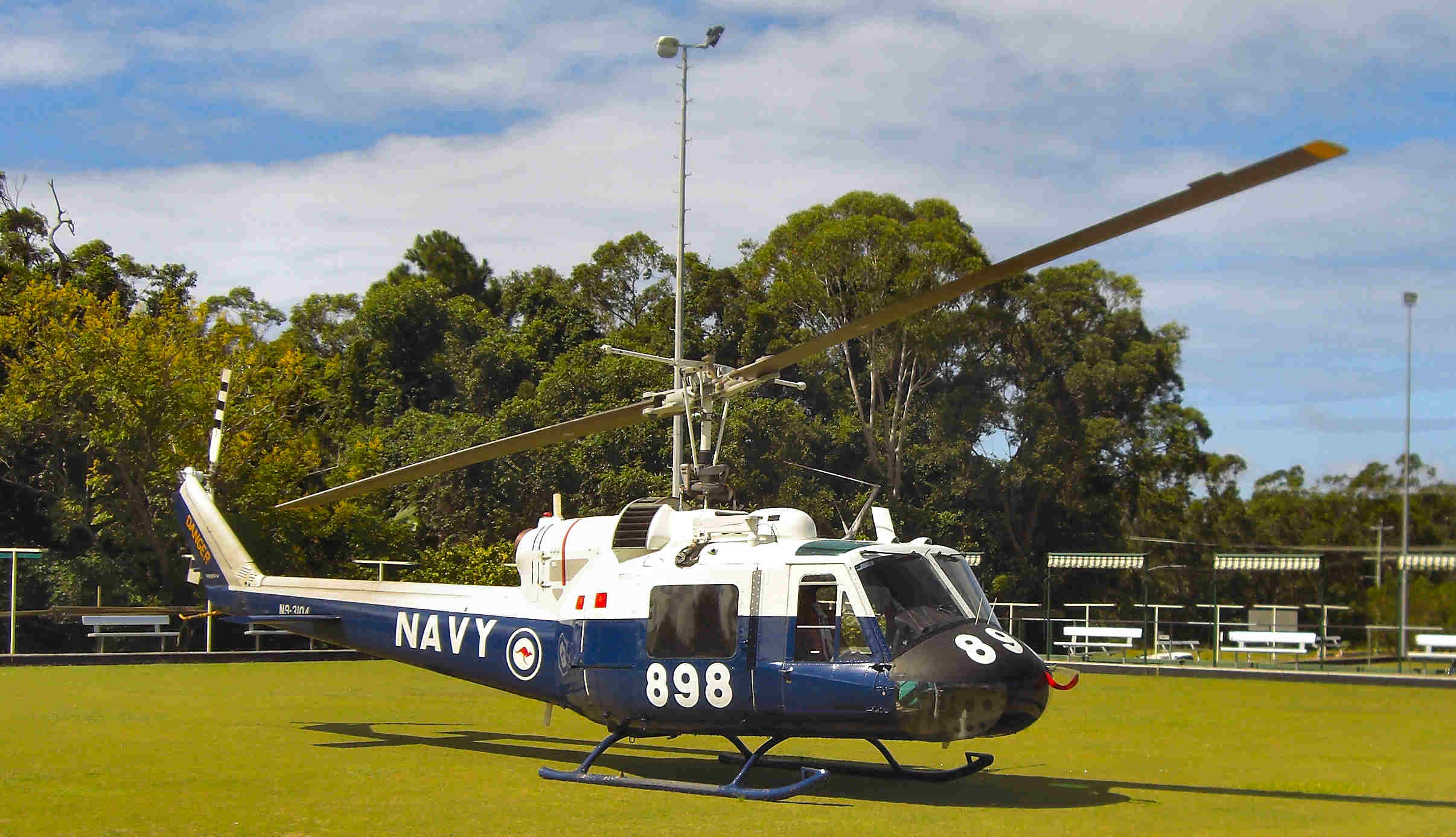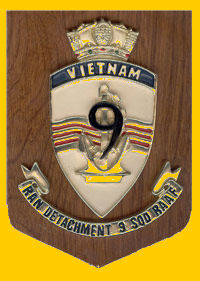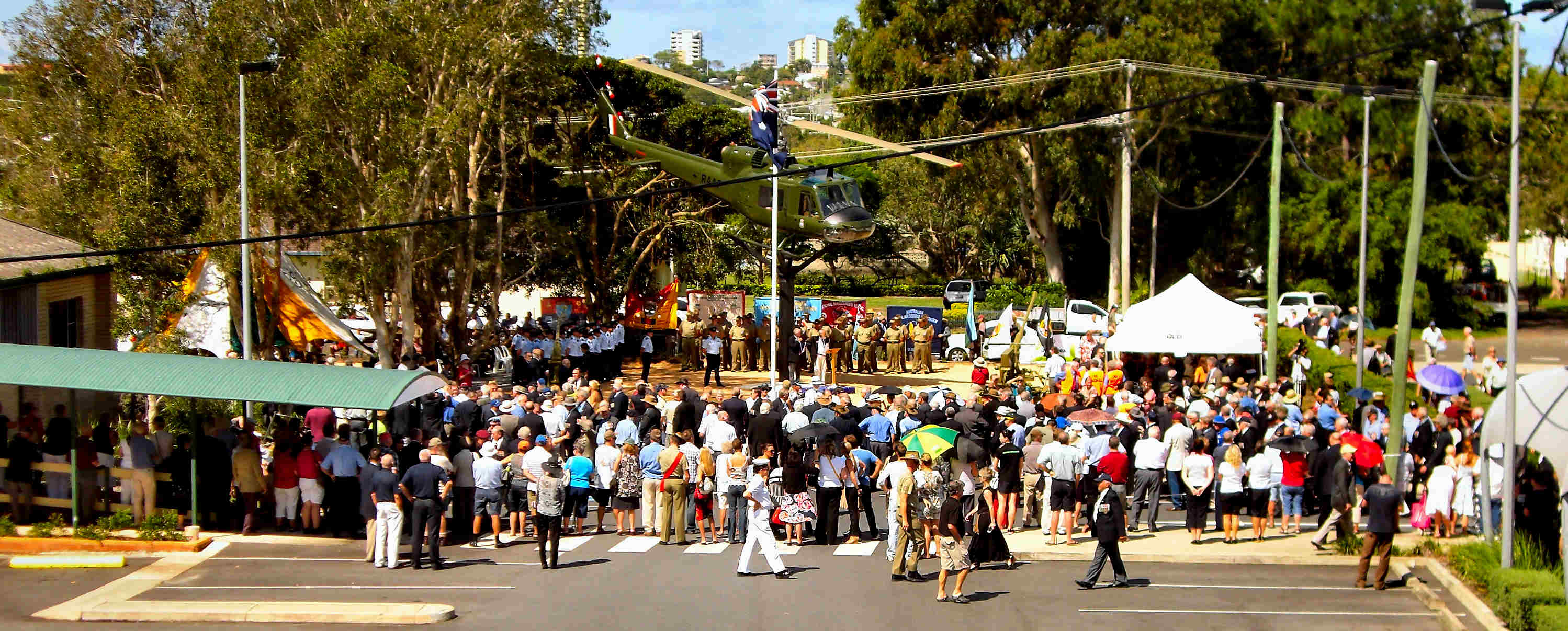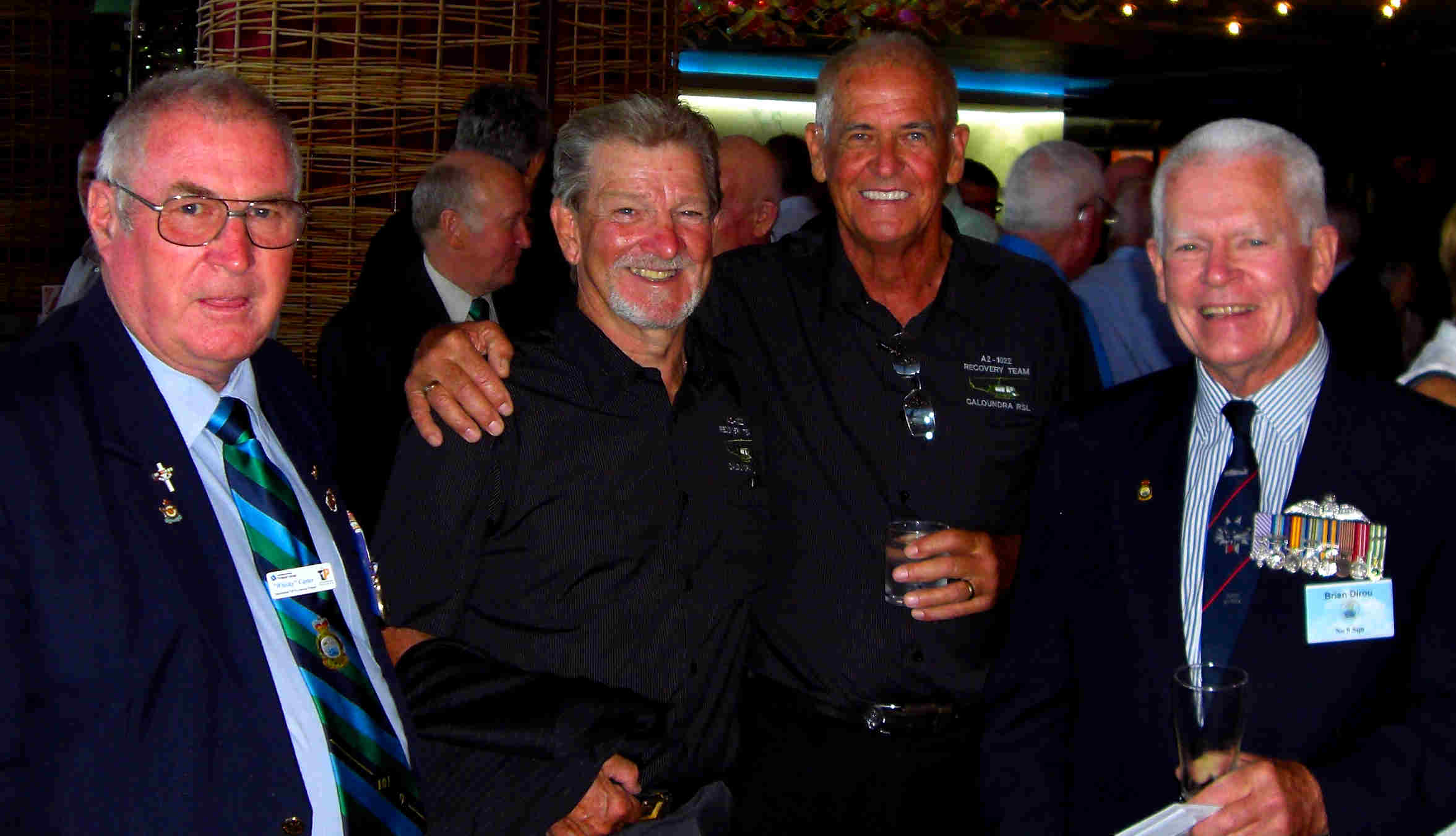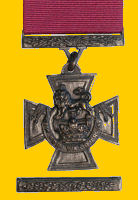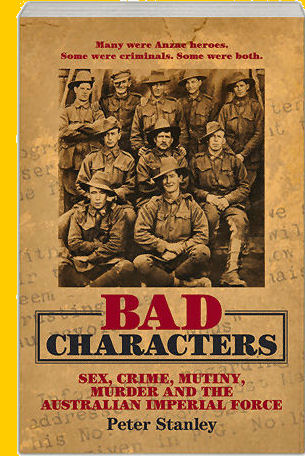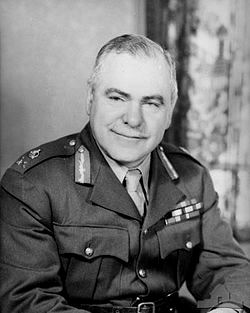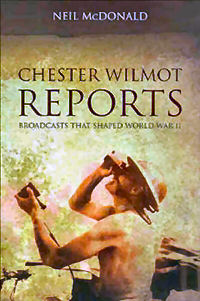|
|
||||||||||||||||||||||||||||||||||||
|
Radschool Association Magazine - Vol 39 Page 12 |
||||||||||||||||||||||||||||||||||||
|
Privacy Policy | Editorial Policy | Profit Policy | Join the Association | List of Members | Contact us | Index | Links |
||||||||||||||||||||||||||||||||||||
|
Back Go to page: 1 2 3 4 5 6 7 8 9 10 11 12 13 14 15 16 17 18 19 20 Forward |
||||||||||||||||||||||||||||||||||||
|
|
||||||||||||||||||||||||||||||||||||
|
Iroquois A2-1022
On Friday the 16th March, 2012, an Iroquois aircraft with RAAF serial number A2-1022, was ceremoniously dedicated at the Caloundra (Qld) RSL. Miraculously, it was the only fine day that the Sunshine Coast had had for weeks and it hasn't stopped raining since. It was suggested that the reason for this was because God was a 9 Sqn Framie in a previous life. (Click on some of the photos for bigger view)
|
||||||||||||||||||||||||||||||||||||
|
|
||||||||||||||||||||||||||||||||||||
|
A2-1022 was one of the early B model Iroquois aircraft purchased and flown by the RAAF and in itself, was not all that special. The RAAF bought the B Models in 3 batches, the 300 series were delivered in 1962, the 700 series in 1963 and the 1000 series were delivered in 1964. A2-1022 was of the third series and was just an Iroquois helicopter, an airframe with an engine, rotor, seats etc, much the same as all the other sixteen thousand or so that were built by the Bell helicopter company all those years ago – it was nothing out of the ordinary. So why did so many people give up their Friday to come and stand around in the hot sun for an hour or more just to see this one?? The reason they did was because there is quite a story associated with this particular aircraft and as is usually the case, the story is more about the people who flew it, flew in it and who fixed it – not about the aircraft itself.
It belonged to 9 Squadron which arrived in Vietnam, in a roundabout route, in June 1966 with 8 of this type of aircraft and was given the task of providing tactical air transport support for the Australian Task Force. When it arrived in June 1966, 9 Sqn was not fully equipped to wage war. The Defence Department had insisted the squadron would be given several years' notice before being sent into a conflict but it was given only 12 weeks before being deployed and that’s a big ask on the men who flew and worked the aircraft and it was a big ask on the aircraft itself. When they arrived in Nui Dat, only two of the eight Iroquois were fitted with armoured seats and none had door gun mounts. None of the aircrew had chest protectors. By the time they were called on to supply D Company, all aircraft had been fitted with armoured seats and had door gun mounts fitted. Unfortunately, this early ‘non-readiness’ was to cause some friction between the RAAF and the Army with the Army labelling 9 Sqn ‘a bunch of chickens’ as it reasoned ‘they’re here, so they should be able to provide assistance as and when required”. In ensuing months, once up to speed, they did, 9 Squadron conducted themselves honourably and courageously, but the damage was done and the classification stuck.
At dawn on the early morning mortaring on the 17th, B Company 6RAR was sent out to locate the mortar positions, estimated from compass bearings of the firing sounds to be near the Long Tan rubber plantation some 3000metres northwest of the deserted village of Xa Long Tan. They had no rations or sleeping gear and expected to be back in base by noon. They located five vacated 82mm mortar positions and were told to remain out overnight and be relieved on the 18th. Delta Company was assembled early on the 18th from security duties and ordered out to relieve B Company and continue the search for maybe 50 enemy of the local D445 battalion. B Company sent 48 men back to base for leave, there being no obvious threat at Long Tan. After relieving B Company at 2pm, D Company pushed carefully into the rubber and contacted a small VC patrol which fled east. 11 platoon followed up, to be met by enemy who had moved forward to investigate the intrusion. The action developed into a company defensive battle. Soon more than 2000 enemy troops had enveloped the 108 soldiers of D Company and a fierce battle followed. The soldiers were running low on ammunition and without a new supply they would have been overrun in a very short period of time. Visibility was poor and teeming rain and a low cloud brought on an early darkness.
|
||||||||||||||||||||||||||||||||||||
|
You can download a fact sheet on the Long Tan battle HERE..
To read a background report on the battle, written by Harry Smith, click HERE.
Late in the afternoon, as the Battle raged, Australian Army Commander Brigadier David Jackson (right) became a very worried man. Harry Smith had requested ammunition resupply by helicopter so Jackson urged Group Captain Peter Raw, who was the Task Force's senior RAAF officer to get his helicopters into the air to resupply his troops, but because of RAAF Canberra policy, 9 Sqn helicopters were not then permitted to fly into dangerous areas, Raw hesitated. 34 year old pilot, Flt Lt Frank Riley suggested strongly that the supply flight go ahead and Raw eventually and reluctantly authorised the mission and the aircraft were loaded with the precious ammunition. They were all aware that they could lose at least one aircraft and it was agreed that two helicopters be loaded, just in case. One of those helicopters was A2-1022.
Just
before 6pm the two Iroquois were airborne. A2-1020 was piloted by
Flt Lts Frank Riley with co-pilot Bob Grandin (right) and down the
back
The ammunition arrived in the nick of time, saving Delta Company from almost certain annihilation. Frank Riley was awarded a Distinguished Flying Cross for his part in the supply flight but so many of Harry Smith's troops on the ground, went unrecognised by officialdom (see HERE).
|
||||||||||||||||||||||||||||||||||||
|
In 1968, the B models were returned to Australia and 9 Sqn took delivery of 16 of the larger and more powerful H models. A2-1022 was one of the aircraft that returned to Australia where it had an eventful life, then after it was decommissioned, it was gifted to the people of the Bogan Shire in NSW by the Australian Government in recognition of the ADF’s work in support of the community during the 1990 Nyngan Floods (the RAN did most of the work with their Sea Kings). It stood on a pad in the town of Nyngan, with no visible indication of its historical military value and due to vandalism and the weather, it gradually deteriorated.
The other aircraft, A2-1020 is displayed at the RAAF Museum in Point Cook.
The difference in the two types of aircraft is as below:
|
||||||||||||||||||||||||||||||||||||
|
||||||||||||||||||||||||||||||||||||
|
|
||||||||||||||||||||||||||||||||||||
|
The
name Huey came from the original ‘name’ given to the aircraft by the
Bell Company.
Some years ago, A2-1022 was spotted in Nyngan by someone who knew the significance of that particular aircraft and, as is usually the case, over a few beers a plan was hatched to get that aircraft, fix it up and bung it on a pole at the Caloundra RSL.
Bob McInnes, who spent time with 5 Sqn in Butterworth, was instrumental in persuading the Bogan Shire Council to swap their aircraft for a similar aircraft so that the historically significant A2-1022 could be restored and displayed at the RSL - and the rest is history.
You can read more on this HERE and HERE.
Bob and the team took on the task and for nearly 3 years devoted their Tuesdays and Thursdays to rebuilding two aircraft, one to go to Nyngan, the other to be installed at the RSL. Friday the 16th March, 2012 was set aside as ‘Dedication Day’ and everyone was invited to attend.
Special guests included:
|
||||||||||||||||||||||||||||||||||||
|
||||||||||||||||||||||||||||||||||||
|
|
||||||||||||||||||||||||||||||||||||
|
Current Servicemen and Women from RAAF Amberley and 6 RAR Enoggera and past members of 9 Squadron, 6 Battalion RAR, Australian Special Air Service, 105 Field Battery RAA and old Nashos formed up on the roadway in front of the RSL and to the music supplied by the Australian Army Band, Brisbane, marched along the roadway to the rear of the Club to where the helicopter had been mounted.
|
||||||||||||||||||||||||||||||||||||
|
|
||||||||||||||||||||||||||||||||||||
|
Part of the 9 Sqn contingent.
|
||||||||||||||||||||||||||||||||||||
|
|
||||||||||||||||||||||||||||||||||||
|
Once arrived at the helicopter, the gathering (below) was addressed and welcomed to the ceremony by Bob McInnes who thanked all the generous businesses which had donated money or services to enable the project to be conceived and completed. A special thanks was made to McDermott Aviation in Cooroy, (north of Caloundra) which donated an Iroquois airframe to the team which was restored and which was swapped for A2-1022 in Nyngan.
|
||||||||||||||||||||||||||||||||||||
|
|
||||||||||||||||||||||||||||||||||||
|
The gathering was then addressed by Angus Houston. Angus was born in Scotland and immigrated to Australia in 1968 when aged 21. He applied for and was accepted into the RAAF as a trainee pilot in 1970 and spent a major part of his career flying helicopters in various parts of Australia, Papua New Guinea and Indonesia. He recounted the number of times he had flown the aircraft perched above his head.
|
||||||||||||||||||||||||||||||||||||
|
From 1978 until 1980, he was posted to 9 Sqn at Amberley and in 1979 was awarded the Air Force Cross (AFC) for an open sea rescue in gale force winds off Evans Head on the northern coast of New South Wales.
He was posted to the Department of Air (Development Division) where he was involved in the Black Hawk Helicopter Project, then in 1987, he was posted back to Amberley and appointed as CO of 9 Squadron while the Squadron was replacing its Iroquois with the Black Hawk. Shortly after, he oversaw the Squadron’s move from Amberley to Townsville, then managed the handover of the aircraft and support equipment to the Australian Army as a result of which he was admitted as a member of the military division of the Order of Australia. In 1989 he served one year as a Squadron Commander with the 5th Aviation Regiment.
He was promoted to Group Captain in July 1992 and assumed the post of Director Air Force Policy and negotiated the establishment of the RSAF Flying School at Pearce. After completing a C-130H conversion in 1993, he commanded No. 86 Wing from 1994–1995.
He was appointed as Chief of Air Force (CAF) on 20 June 2001 and, in the 2003 Australia Day Honours, advanced to Officer of the military division of the Order of Australia. As acting Chief of the Defence Force in 2001, he played a central role in the Children Overboard Affair. At a Senate inquiry in February 2002, he challenged the then government's claim made during the 2001 election campaign, that sea-faring asylum seekers had thrown children overboard in a presumed ploy to secure rescue and passage to Australia.
On 4 July 2005, he was promoted to Air Chief Marshal and appointed Chief of the Defence Force (CDF) with his appointment extended to the 3rd July 2011, after which he retired having devoted 41 years of service to the RAAF, to the ADF and to Australia. |
||||||||||||||||||||||||||||||||||||
|
It was then Harry Smith’s turn to address the gathering. Harry was born in July 1933, in Hobart Tasmania, and although that's south of Oatlands, being a Tasmaniac automatically makes him a damn good bloke.
He was Nashoed in 1952 and liked the Army so much that after his term was up, he applied for officer school in the regular Army, was accepted and was sent to Officer Cadet School at Portsea in Victoria. In June 1966, having reached the rank of Major, (that’s Sqn Ldr in the real money), he was posted to Vietnam as the OC of D Coy, 6RAR. On 18 August, after the shelling of Nui Dat, he led the soldiers of D Coy out on patrol to look for the enemy but ran into a huge force of North Vietnamese at Long Tan.
Under his command, D Coy fended off a numerically superior force, with at least 245 Vietnamese confirmed as killed and another 300 believed wounded. 15 Australians were given bravery awards, but many of these had been downgraded from the original nomination. Smith’s leadership of his men during the fierce fighting saw him recommended for the Distinguished Service Order, but he instead received the Military Cross. On 14 August 2008, after years of campaigning for better recognition for his men who fought in the Long Tan battle, several of them had their bravery awards upgraded and his own Military Cross was rightly upgraded to the Star of Gallantry.
Click HERE to see the video of Harry being presented with the MC - unfortunately, there is no sound.
On 9 March 2011 at the Maryborough Military and Colonial Museum, (Qld) he was presented with the Star of Gallantry by local MP Paul Neville. Many of the Long Tan veterans were in attendance for the ceremony.
Without his leadership, it has been strongly suggested that things would have been very different and Australian losses would have been far greater. A lot of 6RAR blokes owe him an awful lot!
He retired from the Army in 1976 with the rank of Lieutenant Colonel (Wng Cdr). |
||||||||||||||||||||||||||||||||||||
|
Bloke in his armchair shouts to his wife "When I die I'm going to
leave everything to you love" |
||||||||||||||||||||||||||||||||||||
|
The dapper Peter Slipper, the Speaker of the House of Representatives and the Member for Fisher, which takes in Caloundra, addressed the assembly and you can see and hear his address HERE. |
||||||||||||||||||||||||||||||||||||
|
|
||||||||||||||||||||||||||||||||||||
|
|
||||||||||||||||||||||||||||||||||||
|
Barry Johnson, the RSL Sub-Branch President, then introduced the blokes who had done all the work. Without their foresight, dedication and hard work, the whole thing would not have happened. A big thank you to them all.
|
||||||||||||||||||||||||||||||||||||
|
L-R: Max Baxter RAAF, Barry Walker, (sunglasses light shirt and Sub branch Sec), John Dunn RAAF, Bob McInnes RAAF, Roy Robinson RAAF, Ingo Meier RAAF, Quentin McCutcheon (looking left) RAAF, Rob Gee (partially obscured) RAAF, Kerry Millard RAAF, Bill Wiggett Army, Ian Newham Civvie.
|
||||||||||||||||||||||||||||||||||||
|
Two good blokes.
These two blokes, without whom the day would not have happened, are Bob McInnes (left) and Harry Smith. Bob acted as the WOD and kept the restoration blokes dedicated, enthusiastic and motivated and got the job done and Harry, who turns a fit 79 this year, and who brilliantly led his blokes out of a very nasty situation all those years ago, for reasons unknown, has not been adequately recognised for the marvellous work done in saving so many lives.
|
||||||||||||||||||||||||||||||||||||
|
|
||||||||||||||||||||||||||||||||||||
|
Paul Spackman (below left), who was a framie with 9 Sqn from January 1969 to October 1969, with Bob McInnes. We asked Paul to give us some recollections of his time in Vung Tau but he says he can’t remember much about it, reckons it was all a bit of a daze really…..funny that, but it was hot!
|
||||||||||||||||||||||||||||||||||||
|
|
||||||||||||||||||||||||||||||||||||
|
We asked Bob, now that the job was finished, what was his next project, he said “sit on the sand at King’s Beach and watch the girls go by”………..might join him!!
|
||||||||||||||||||||||||||||||||||||
|
Navy Chopper.
|
||||||||||||||||||||||||||||||||||||
|
|
||||||||||||||||||||||||||||||||||||
|
In 1967, when 9 Sqn was re-equipping with the more powerful UH-1H aircraft, they found they were short of pilots to fly the extra machines so the Navy was asked to temporarily fill the gap. In 1968, 8 RAN Fleet Air Arm pilots were assigned to 9 Squadron – see HERE.
9 Sqn had been involved with the Navy for many years. When formed in Jan 1939, 9 Sqn’s Seagull V amphibious aircraft, commonly referred to as ‘the Walrus’, were designed to be embarked on Royal Australian Navy cruisers to provide reconnaissance, anti-submarine and artillery-spotting. During WWII, Squadron personnel invariably suffered the same fate as the ships in which they were embarked. In a night action off Guadalcanal on 8 August 1942, five squadron personnel were killed and a further two wounded when HMAS Canberra was sunk. Similarly, when HMAS Sydney was lost with all hands in an action on 19 November 1941, six squadron members were among those killed. Another five personnel died on 1 March 1942 when HMAS Perth was sunk in the Sunda Strait.
With a partnership dating so far back, it was only natural that the Navy would send their Iroquois and personnel to the party. Navy ordered their 7 UH-1B aircraft back in 1963 and the first was delivered in March 1964. The RAAF accepted delivery of their first on the 29 October 1962.
The aircraft above was delivered to the Navy in 1965 and was involved in a serious accident in Nowra in 1971. This required a complete rebuilt. It was withdrawn from service in May 1989 and allocated to the Navy’s Fleet Air Arm Historic Flight, was rebuilt once again and is now regularly flown to special events. It holds the civilian registration VH-NCC and is based at Nowra.
Part of the crowd who gave up their Friday to witness the dedication.
|
||||||||||||||||||||||||||||||||||||
|
|
||||||||||||||||||||||||||||||||||||
|
Re-living the moment.
These 4 blokes, who were all posted to 9 Sqn are:
|
||||||||||||||||||||||||||||||||||||
|
L-R: Wayne “Whisky” Carter, (May 1968 – May 1969) Electrician; Kerry Millard, (Nov 1970 – Aug 1971) Framie and crewy; Roy Robinson (Apr 1968 – Apr 1969) metal basher and Brian Dirou, who was Sqn Ldr pilot and who did two tours (Mar 1968 – June 1969 and June 1971 – Oct 1971). Brian was instrumental in converting the Iroquois to the gunships (Bushrangers) that were so successful.
|
||||||||||||||||||||||||||||||||||||
|
There is an excellent doco ‘movie’ called “The Battle of Long Tan” which was produced by Martin Walsh and is narrated by Sam Worthington. It features interviews with most of the persons involved in the battle and is a must see. You can download a copy of it HERE. It is a 100 minute movie and is a large file so allow at least 30 minutes to download it. We suggest you save it to your computer before trying to view it.
And we’d like to remind Angus Houston that it’s not necessary to be an officer to have a first name. Referring to the crewies on the two choppers which carried out the supply drop at Long Tan as Lac this and Cpl that is nothing but a snobbish bloody insult.
|
||||||||||||||||||||||||||||||||||||
|
In the movies - Once applied, lipstick will never rub off - even while scuba diving.
|
||||||||||||||||||||||||||||||||||||
|
|
||||||||||||||||||||||||||||||||||||
|
|
||||||||||||||||||||||||||||||||||||
|
Bruce Haigh
Posthumous examination and recognition of exceptional acts of bravery during active service is fraught with pitfalls.
Strong claims have been made over the years by concerned and well-motivated individuals and organisations that a number of Australians who performed extraordinary acts of courage during wartime hostilities and whose acts went unrecognised or were insufficiently recognised, should now, after proper consideration and deliberation, be awarded posthumous VCs.
The Defence Honours and Awards Tribunal has been set up by the Australian Government to ascertain whether certain individuals, who are said to have carried out exceptional acts of bravery during active service, but who remain unrecognised, should now receive that recognition in the form of a posthumous Victoria Cross.
The Victoria Cross of Australia was instituted in 1991 and is a direct descendent of the British Victoria Cross which used to be awarded to eligible Australians. Those often cited for posthumous recognition of the VC include Private John Simpson, of Gallipoli fame, and Ordinary Seaman Teddy Sheean. As Les Carlyon points out in his book, Gallipoli, Simpson did not easily fit the mould of hero, such as people like Albert Jacka, Harry Murray, Arthur Blackburn and ''Snowy'' Howell.
Ordinary Seaman Sheean, aged 19, was a loader on the Australian-built Corvette HMAS Armidale, when it was attacked and sunk by Japanese planes in the Timor Sea in December 1942. Sheean refused to abandon ship, strapped himself to the gun he normally serviced, shot down a Japanese bomber and went down with the vessel.
The Australian historian G. Hermon Gill, who wrote the official history, Royal Australian Navy, 1942-1945, says the ship's captain, Lieutenant-Commander David Richards, RANR(S), singled out Sheean for special mention in the Report of Proceedings of HMAS Armidale and Ordinary Seaman R. M. Caro in an account of the action, detailing the incident and the exceptional bravery of Teddy Sheean.
Of course we have to be careful at what is driving this push to redress forgotten recognition. No doubt there is a strong sense of righting an injustice, of giving credit where credit is due, and properly so. But we also have to be mindful and careful of recent trends to jingoism, overblown nationalism and xenophobia.
In seeking to anoint heroes we have to be careful that we don't airbrush from the picture undesirables who might not fit the public perception of the type of person who should be worthy of elevation.
Historian Peter Stanley in his
book, Bad Characters, says of the First AIF that, ''It should come
as no surprise to find that even VC-winners went absent, caught VD
and came before courts-marshals … Other VCs ran up against the AIF's
disciplinary code as much as their less distinguished comrades.
John Leak, for example, who received a VC for his conduct at Pozieres in July 1916, later had a troubled time. In 1917 he burst into the sergeants' mess at Wareham demanding a drink and refusing a sergeant-major's order to leave, and then went AWL twice. The second time, in November 1917, he was sentenced to imprisonment for life, an extraordinarily harsh sentence. He admitted in his defence - honestly but foolishly - that he ''could not stand shell fire''. Joe Maxwell, the AIF's second-most highly decorated soldier after ''Mad Harry'' Murray, caught VD and was repeatedly in trouble with his superiors in the 18th Battalion. Even in the year in which he was awarded the DCM, MC and VC (and commissioned), Maxwell faced military and civil charges. Maxwell, still only 22, did little else with his life except write the racy and candid memoir, Hell's bells and Mademoiselles.
I hear you say, my sort of man, but is he the sort of man likely to be awarded a posthumous VC by a committee or tribunal? With the new wave of jingoism, Leake and his sad story have been airbrushed out of our history. The Australian War Memorial, in their publication, Wartime Issue 32, Inspirational Bravery, which talks about bravery in battle and awards contains the following sentence, ''In one case an Australian Victoria Cross winner of 1916 was charged with desertion the following year.'' What is wrong in mentioning his name? It seems to me that both Leake and Maxwell might have been suffering from post-traumatic stress, something unrecognised then. Why not say so and give him the dignity he deserves. Not all heroes can fit into or behave according to a schoolboy stereotype.
But the posthumous recognition of outstanding acts of wartime courage seems to me fraught with other possibilities. If the upside is for the Commonwealth, after consideration, to give an award for bravery hitherto unrecognised, surely the logical downside is to remove honours and awards unjustly, unfairly or dishonestly conferred.
Should Lieutenant-General Henry Gordon Bennett be posthumously stripped of his rank and all awards for deserting his troops of the 8th Division, when they were taken into captivity by the Japanese on Singapore?
Bennett slipped the noose and came back to Australia, ostensibly to explain and elaborate on Japanese tactics to a nation facing the prospect of invasion, but more likely to keep himself in the running to be commander in chief of the Australian Army, a post he coveted. Bennett's superior officer and the man in charge of the campaign, General Percival, stayed with his troops and went into captivity.
Should Field Marshall Sir Thomas Blamey be posthumously returned to the rank of general for his appalling handling of the Kokoda campaign, where he allowed the arrogant, over-bearing and vain US General MacArthur to bully, not only senior Australian officers including Blamey, but also the Australian prime minister, John Curtin?
Stuart Braga, the biographer of Major-General ''Tubby'' Allen, in the book Kokoda Commander, says, ''In this culture of utter dependence on the Great Man, Curtin did not insist on the collaborative spirit of MacArthur's appointment being met … Curtin's failure to insist on an effective joint staff at MacArthur's GHQ cost the Australian Army dearly. It was relegated to a subordinate role for the whole of the Pacific War, and employed on campaigns of minor significance. ''
To protect his career Blamey
stood by and watched this development, saying and doing nothing to
advance Australian strategic input. He complied with a directive
from MacArthur to go to New Guinea and take control of the Battle
for Kokoda. Blamey sacked Generals Potts, Allen and Rowell, which
pleased MacArthur but ruined three fine military careers an
Finally, should Chester Wilmot, of the ABC, be given a posthumous award for his honest reporting of the campaign, which Blamey so loathed that he had him withdrawn from PNG? Where does one draw the line?
In the cases under consideration by the tribunal and others that might arise from the precedent created, why not institute a special posthumous award that can be issued by the Parliament of Australia for bravery and courage not previously acknowledged or recognised?
|
||||||||||||||||||||||||||||||||||||
|
Letter to his CO from a Captain answering his CO's "Request for further information."
Sir,
In your icy, indeed hostile, telephone call of yesterday, you requested a report about the alleged proceedings involving my soldiers. As the reports from the local authorities and the head of the Australian legation were undoubtedly a complete fabrication, I welcome the opportunity to put the truth of the matter forward.
Your kind offer to "buy a round of drinks" for the troops at the end of the deployment was taken and the CSM ensured that appropriate quantities of libation and food were purchased against your credit card , with festivities being held in my hotel suite. An enjoyable evening ensued but insufficient supplies had been obtained, so several members of the company left for further purchases at a local bar.
In a truly magnanimous gesture, ten bar girls from that establishment helped carry the beer back to the hotel. To demonstrate our appreciation of their assistance, we served them some cool drink. They then offered to show us some local culture, and, in order not to offend, we allowed them to dance.
The banging on the walls of my room had, by now, quite honestly, become invasive, and it was disturbing the dancers, so we arranged an amusing little deterrent. LT Brown's impersonation of a Police Officer was quite clever as he goose-stepped to each room and harangued the occupants with a very witty diatribe about disturbing hotel guests. I personally heard nothing of his alleged threats to life or limb in as claimed by the sister of the local Police Chief whose room was, unluckily, next door.
I suspect that this woman was the sneak who called security and hotel management but I absolutely refute that the shout "Stand To, enemy approaching!" was made. The simple coincidence of security arriving just as we stood the double bed on its side across the door to make the dance floor bigger is obvious. The major damage to the room occurred when a group of gate crashers, whom we could not know were hotel security, forced their way in just as most of us happened to be leaning against the bed watching the dancing.
The subsequent events in the foyer of the hotel are an equally vicious distortion of the facts. I was explaining the importance of the post activity celebrations to the General Manager of the hotel, and stating that other guests were obviously fabricating their stories of the noise and drinking, when CPL Smith and several others from HQ Coy (in keeping with their pursuit of physical fitness) organised the race up the drapes which hang along the foyer wall. It says little for the workmanship that the fittings were torn from the wall before most of the company was even halfway up.
At this stage SGT Williams, our Orderley Room SGT attempted to rescue the situation with her depth of knowledge of local culture. Her rendition of the Fertility Dancing Maiden in the foyer's 'Pool of Remembrance' was nothing short of breathtaking. Normally this dance is performed wearing just a sarong skirt but SGT Williams' extra step to " Au Natural" was a bold step forward. Unfortunately, during one intricate step, SGT Williams slipped and fell beneath the fountain, but we were lucky that SSGT Johnson had the great presence of mind to strip to avoid getting his uniform wet, leapt in to help.
The tiles of the pool were very slippery and it took nearly ten minutes of threshing about before he could actually complete his rescue. Such concern was there for these two exemplary member's safety, that the many of company jumped in to assist, and I deny that this massed rescue attempt could be construed as a 'Water Polo' game!
Order had nearly been restored when the fire started. I prefer CPL White's version of events that the drapes had caught fire from being against a light fitting, and that he dropped his cigarette lighter whilst trying to escape the flames. Had hotel management fulfilled their responsibilities and used fire retardant material instead of velvet, the fire would not have spread to the rest of the hotel.
The responsible attitude shown by my soldiers in assisting the bar staff to carry out drinks from the cocktail party is to be commended, not condemned, and the attempt by many male members to extinguish pockets of fire using natural means has been totally misrepresented in some quarters.
I made an official protest about these matters when the head of the Australian Legation visited us at the Police Station the next morning. However, not only did Ambassador Downey not attempt to refute the preposterous allegations made against me and my soldiers crew, but also failed to secure our release immediately.
I trust that now I have outlined the correct version of events, we may allow ourselves a discreet smile as to the lack of social sophistication of some of these developing nations and put all this behind us. In my opinion my soldiers behaved in accordance with the finest Australian Army traditions.
Your most obedient servant,
|
||||||||||||||||||||||||||||||||||||
|
Back Go to page: 1 2 3 4 5 6 7 8 9 10 11 12 13 14 15 16 17 18 19 20 Forward |
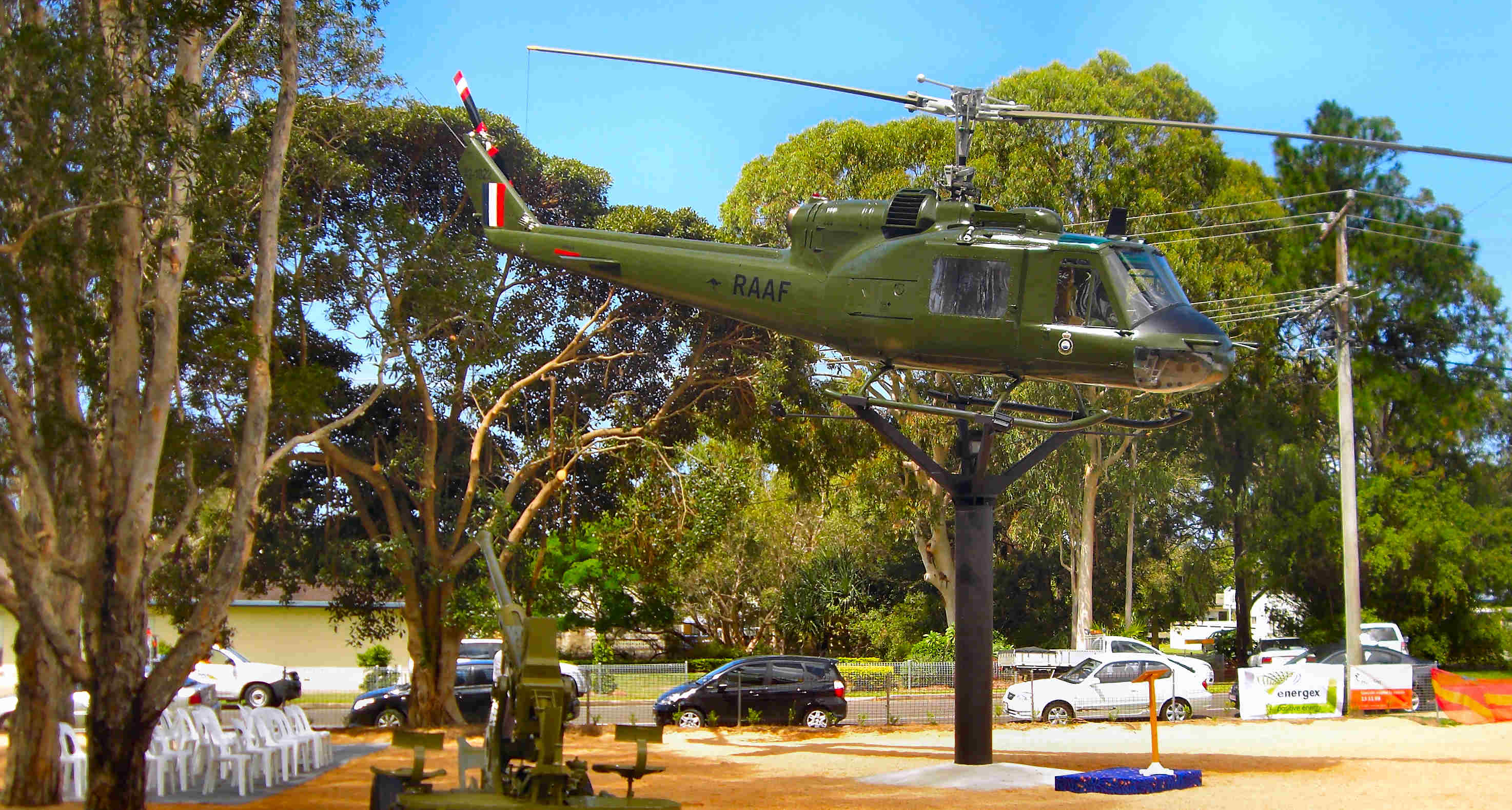

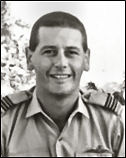
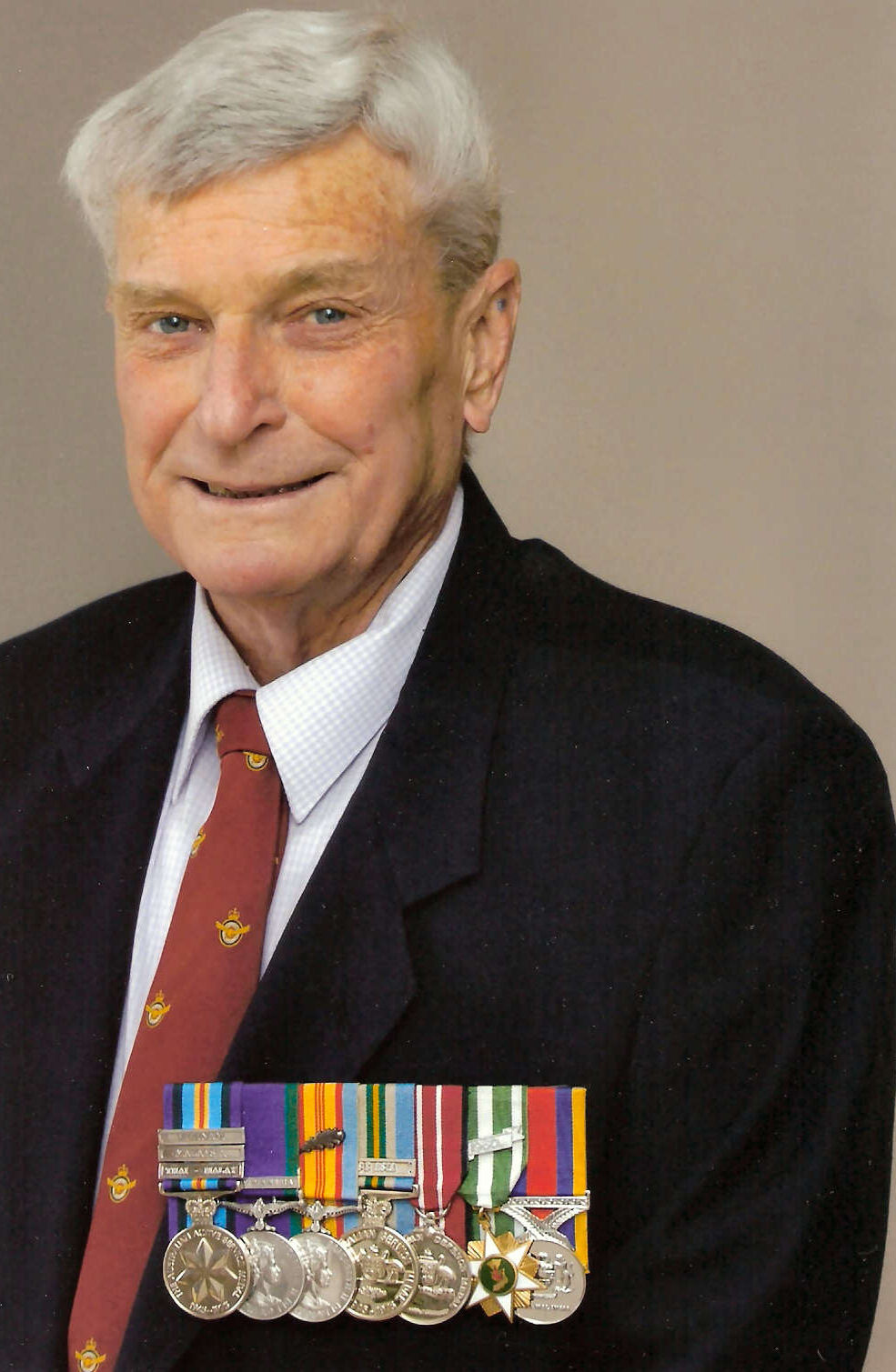 were
LAC’s Dave ‘Bluey’ Collins (crewy) and John Stirling (gunny).
A2-1022 was piloted by Flt Lts Cliff Dohle (left) (
were
LAC’s Dave ‘Bluey’ Collins (crewy) and John Stirling (gunny).
A2-1022 was piloted by Flt Lts Cliff Dohle (left) (